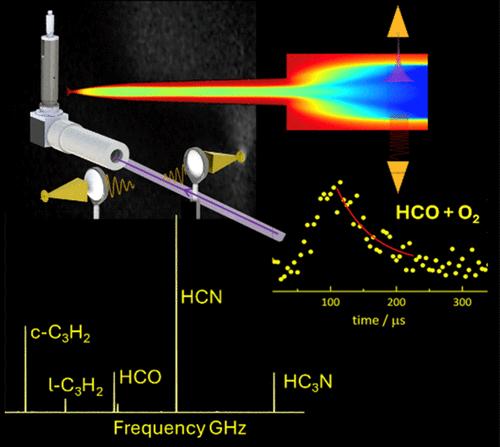当前位置:
X-MOL 学术
›
Acc. Chem. Res.
›
论文详情
Our official English website, www.x-mol.net, welcomes your
feedback! (Note: you will need to create a separate account there.)
Broadband Rotational Spectroscopy in Uniform Supersonic Flows: Chirped Pulse/Uniform Flow for Reaction Dynamics and Low Temperature Kinetics
Accounts of Chemical Research ( IF 16.4 ) Pub Date : 2024-10-15 , DOI: 10.1021/acs.accounts.4c00489
Nureshan Dias 1 , Nicolas Suas-David 2 , Shameemah Thawoos 3 , Arthur G Suits 3
Accounts of Chemical Research ( IF 16.4 ) Pub Date : 2024-10-15 , DOI: 10.1021/acs.accounts.4c00489
Nureshan Dias 1 , Nicolas Suas-David 2 , Shameemah Thawoos 3 , Arthur G Suits 3
Affiliation

|
The study of gas-phase chemical reactions at very low temperatures first became possible with the development and implementation of the CRESU (French acronym for Reaction Kinetics in Uniform Supersonic Flows) technique. CRESU relies on a uniform supersonic flow produced by expansion of a gas through a Laval (convergent-divergent) nozzle to produce a wall-less reactor at temperatures from 10 to 200 K and densities of 1016–1018 cm–3 for the study of low temperature kinetics, with particular application to astrochemistry. In recent years, we have combined uniform flows with revolutionary advances in broadband rotational spectroscopy to yield an instrument that affords near-universal detection for novel applications in photodissociation, reaction dynamics, and kinetics. This combination of uniform supersonic flows with chirped-pulse Fourier-transform microwave spectroscopy (Chirped-Pulse/Uniform Flow, CPUF) permits detection of any species with a modest dipole moment, thermalized to the uniform temperature of the gas flow, with isomer, conformer, and vibrational state specificity. In addition, the use of broadband, high-resolution, and time-dependent (microsecond time scale) micro- and mm-wave spectroscopy makes it an ideal tool for characterizing both transient and stable molecules, as well as studying their spectroscopy and dynamics.
中文翻译:

均匀超声速流中的宽带旋转光谱:用于反应动力学和低温动力学的啁啾脉冲/均匀流
随着 CRESU(均匀超音速流中的反应动力学的法语首字母缩写)技术的开发和实施,极低温度下气相反化学反应的研究首次成为可能。CRESU 依靠气体通过 Laval(收敛-发散)喷嘴膨胀产生的均匀超音速流,在温度为 10 至 200 K、密度为 1016-10 18 cm-3 的温度下产生无壁反应器,用于低温动力学研究,特别是天体化学。近年来,我们将均匀流动与宽带旋转光谱学的革命性进步相结合,产生了一种为光解离、反应动力学和动力学等新应用提供近乎通用检测的仪器。这种均匀的超音速流与啁啾脉冲傅里叶变换微波光谱(啁啾脉冲/均匀流,CPUF)的结合允许检测具有适度偶极矩的任何物质,这些物质被热化到气流的均匀温度,具有异构体、构象异构体和振动状态特异性。此外,宽带、高分辨率和时间相关(微秒时间尺度)微波和毫米波光谱的使用使其成为表征瞬态和稳定分子以及研究其光谱和动力学的理想工具。
更新日期:2024-10-15
中文翻译:

均匀超声速流中的宽带旋转光谱:用于反应动力学和低温动力学的啁啾脉冲/均匀流
随着 CRESU(均匀超音速流中的反应动力学的法语首字母缩写)技术的开发和实施,极低温度下气相反化学反应的研究首次成为可能。CRESU 依靠气体通过 Laval(收敛-发散)喷嘴膨胀产生的均匀超音速流,在温度为 10 至 200 K、密度为 1016-10 18 cm-3 的温度下产生无壁反应器,用于低温动力学研究,特别是天体化学。近年来,我们将均匀流动与宽带旋转光谱学的革命性进步相结合,产生了一种为光解离、反应动力学和动力学等新应用提供近乎通用检测的仪器。这种均匀的超音速流与啁啾脉冲傅里叶变换微波光谱(啁啾脉冲/均匀流,CPUF)的结合允许检测具有适度偶极矩的任何物质,这些物质被热化到气流的均匀温度,具有异构体、构象异构体和振动状态特异性。此外,宽带、高分辨率和时间相关(微秒时间尺度)微波和毫米波光谱的使用使其成为表征瞬态和稳定分子以及研究其光谱和动力学的理想工具。




































 京公网安备 11010802027423号
京公网安备 11010802027423号